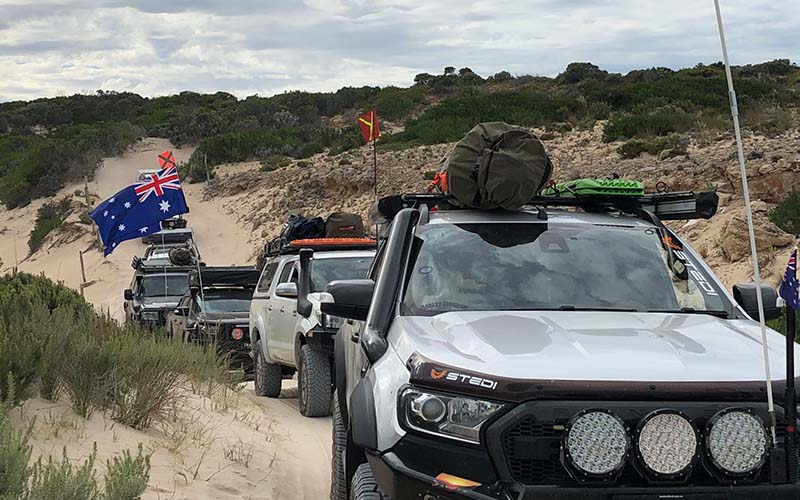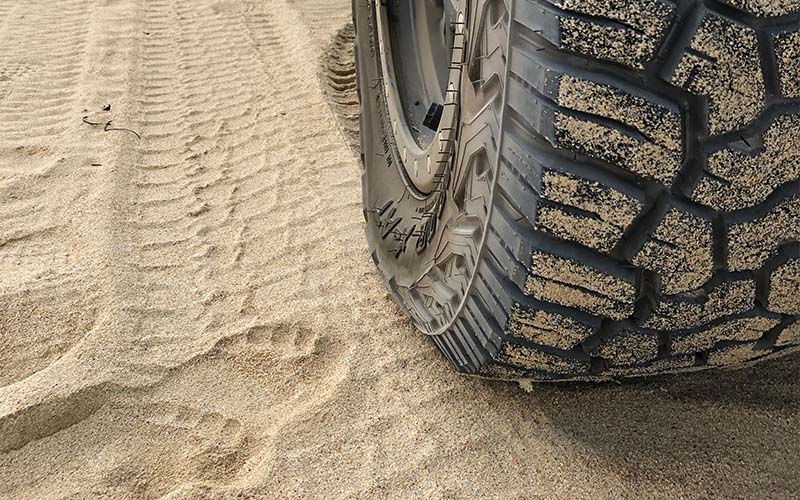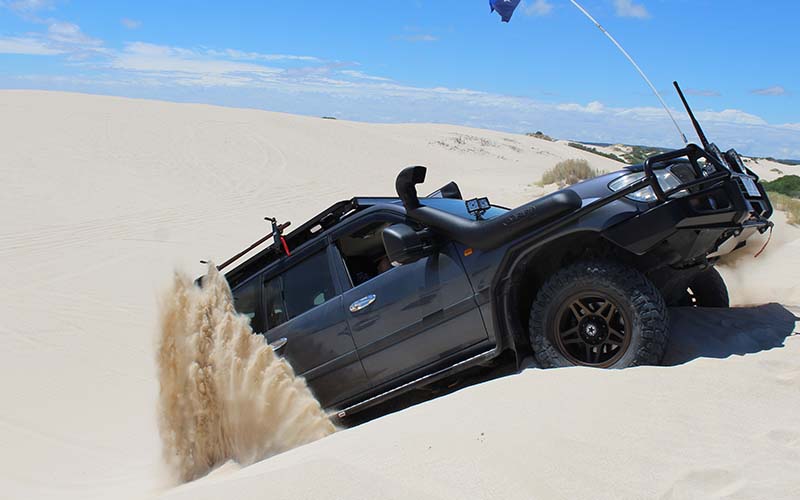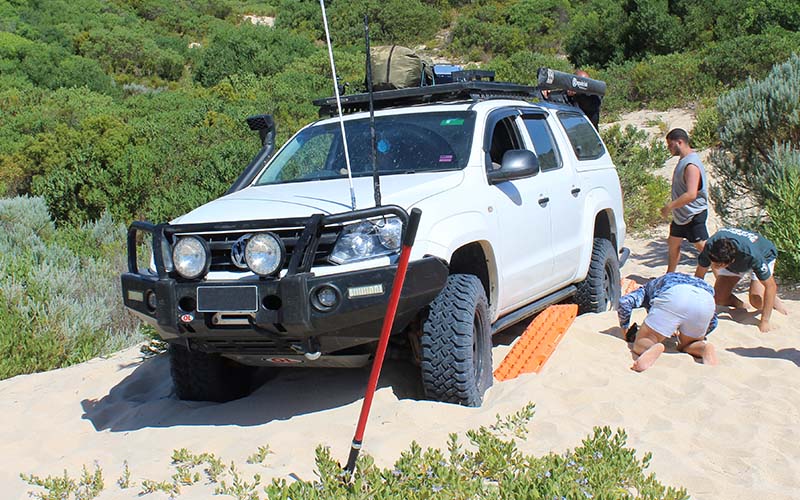The land down under that we're lucky enough to call home is chock-a-block with beautiful beaches. It's no secret that Oz is known for its surf, sun and sand, and there's no better way to experience the best of what our coastal reaches have to offer than by cruising along in your 4X4. It doesn't matter where you're headed, whether it's Robe in the South, Stockton Beach to the East, Margaret River to the West, or the Northern tip. For something unique you could even check out the world's largest sand island, Fraser Island (K'gari). There's certainly no shortage of sand driving to tackle Down Under.
Driving on the sand isn't always a piece of cake though, and it helps to have a little bit of know-how before hitting the dunes. That's why the BCFing experts have pulled together this beach driving guide — to make sure that you stay safe and more importantly, have fun while tackling the tricky beach tracks. So grab your crew and come beach driving with us today!
Before you go
Like any 4WD adventure, preparation is key, and there are a few things that you'll need to do before you reach the sandy shores. The very first thing is to make sure that your car is up to scratch. Do you need a service? Do your tyres look like they've seen better days? The salt and sand can be pretty brutal, so make sure your car is in good nick before heading off. Spraying the underbody with a bit of lanolin spray such as Inox is a great idea to limit the impact of the salty air and sand. It's also a great idea to assemble a bit of a crew. Beach driving alone can be difficult and dangerous. It's always best to have at least one other car with you.

You'll also want to check the weather and the tides. Quality phone reception in many beach driving locations can be hard to come by, so it's important that you take a screenshot of the weather and tides before heading away (or write it down if you're a bit old school). Keep in mind that a beach at high tide will look completely different to a beach at low tide and that you'll have less room to drive, so don't get stuck.
Before leaving home it's important to have all the right gear. You'll need recovery gear such as a shovel, snatch strap and recovery tracks, UHF communications (a handheld UHF or CB always comes in handy) and a sand flag as well as a few other bits and bobs. For a list of the essential products you'll need for beach driving, check out this gear guide. Lastly, you'll want to double check local regulations. Many beaches require a permit before being driven on, so a little bit of research can mean that you avoid a hefty fine and have more money left over for a cold one at the pub on the way back home.
Hitting the beach
Now for the fun part, the driving! Before you attempt to drive on the sand, you'll need to let some air out of your tyres. As a general guide, 15–20 PSI is a good range to work within, however every rig is different, so it's important to know your vehicle. The aim of airing down is to create a wider ‘footprint' with your tyre so that you have more rubber in contact with the soft stuff. Be careful of letting your tyres out too low though — you don't want your tyre rolling off the rim. A good tip is to air down to 20 PSI, and if you find you're still getting caught up frequently, drop the tyres a little more. The next thing you'll need to do is whack the car into four-wheel drive. Low range is ideal for soft sand and climbing dunes as you'll be able to spin the wheels a little slower to maintain momentum and avoid digging yourself into the soft sand.

Once you're on the beach, don't forget that road rules still apply. Wear a seatbelt, stick to the left if you see a car passing from the other direction, and limit your speed to under 60km/h. On many beaches, this is a speed limit that you must follow. When driving on the beach in general, it's a good idea to keep your speed low and your wheels turning. 40km/h is a more realistic speed to maintain when driving along the sand. Keep on the accelerator and maintain a consistent speed if you want to avoid sinking or getting bogged. If there's one piece of advice that you should remember, it's that momentum is key, so keep on the accelerator until you're out of the soft stuff. Another way to avoid getting stuck is to drive on existing ruts as the sand will often be a little firmer. If you ever need to spin the car around, turn with the slope of the beach rather than turning up the beach — gravity is your best friend here.
Speaking of gravity, when attempting to drive up the dunes it's important you have your wheels and vehicle facing straight up the hill. Driving on an angle isn't a smart idea and can leave you in a pretty sticky situation if the car ends up on its head. When tackling the dunes, it's time to give it the berries! Big dunes require a bit of speed to get up, so don't be afraid to hit the pedal to the metal when climbing those sandy slopes. If you get stuck up the hill, don't fret! Just roll the car straight back down the hill and give it another crack! Whatever you do, don't try to spin the car around on the dunes. Remember — straight up, straight down. It's also important to check your local regulations before driving on any sand dunes as many are protected due to nesting animals, fragile ecosystems or erosion.

Don't get 'bogged down'
If you do get stuck in the sand, don't keep spinning wheels! Once you get stuck, take your foot right off the accelerator, and have a breather. You're always best off jumping out of the car to assess the situation. If you're not buried too deep it may be worthwhile to let some air out of the tyres and try to roll the car out of trouble. Putting the car in reverse can help with rolling the car. If that doesn't work, remove some sand from out the front of the wheels to create some room for the car to drive out. If you have a pair of recovery tracks on hand, you can use these to dig the car out before slipping them under the wheels — how good is that! If you're not able to perform a self-recovery using a shovel and recovery tracks, your next best bet will be to call in your mate. Beaches are the perfect place for a snatch recovery, and you should be out of trouble in no time. Just make sure that you are taking the right precautions when using a snatch strap. Never attach your strap onto the tow ball and make sure that everyone stays well clear. In these times, a couple of hand-held radios will be your best friend. Check out this beach recovery guide for a more detailed run down of how to perform a beach recovery.

On the road home (cleaning and car care)
So, you've had a ripper time on the sand and you managed to get unstuck nice and quickly due to the cracker guide you read on the BCF website, now what? Well first of all, it's time to air up! A compressor is a must-have piece of kit for everyone who wants to have a crack at sand driving. You don't want to be hitting the asphalt with flat tyres, so get out that compressor and pump 'em up. Then, it's important that when you get home you spend a good amount of time making sure your car is spick and span. Washing your car with an appropriate wash such as Salty Captain is a must to remove any salt that's stuck on the underside or body of your vehicle. Give the car a good scrub and make sure that every nook and cranny has been looked after. The last thing you want is to have corrosion on your vehicle.
Whilst sand driving isn't rocket science, it definitely takes a bit of know-how to avoid getting into some serious trouble. With that said, hitting the beach in your fourbie is an experience like no other and is perfect for beginner and serious 4-wheel drivers alike. If you're after a ripper driving experience that gives you the opportunity to fish, drive and camp in some epic locations, you simply cannot go past sand driving. Get geared up with BCF and head to the dunes with your crew — we're sure you'll have a blast!

